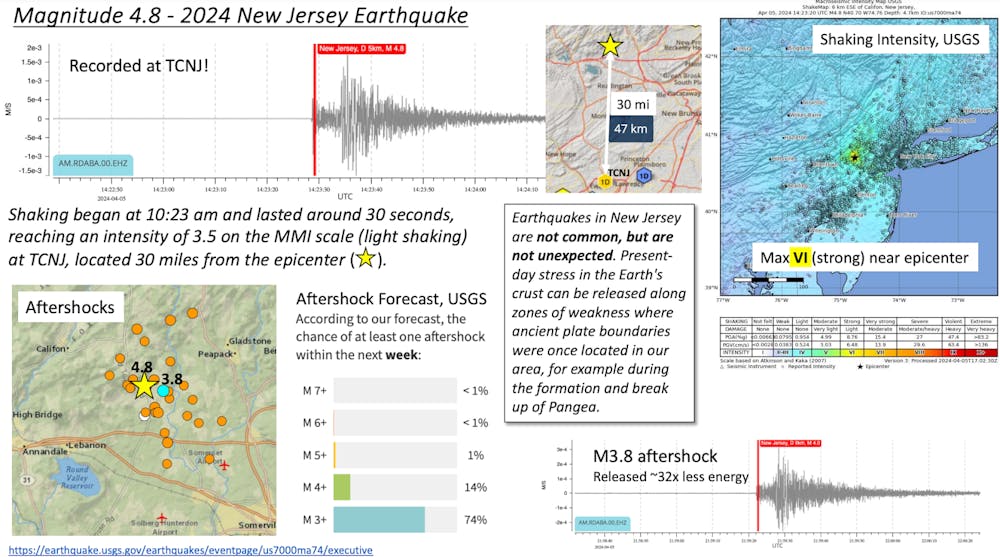By Ally Uhlendorf
Arts & Entertainment Editor
As students in New Jersey, it is not everyday that we wake up due to a natural disaster. Until this past week, when a 4.8 magnitude earthquake hit the tri-state area on April 5 at 10:23 a.m. Here at the College, certain academic buildings were self-evacuated to avoid any damage or injuries.
“It was 10:20 a.m. and I was on the second floor of Kendall Hall, suddenly the entire building began to shake and everyone was so confused,” said junior history and secondary education major Bruce Cohen. “I felt as though the building was going to collapse because of its age.”
The earthquake was the strongest in the state in over 200 years, according to NBC News. The epicenter was about 45 miles of New York City, near Whitehouse Station, New Jersey.
The U.S. Geological Survey reported that over 42 million people might have felt the quake Friday morning, with a reported magnitude of 4.8 — an average magnitude for minor earthquakes. The shake was felt as far north as Maine and as far south as Virginia, according to USGS.
As the earthquake struck during the morning, students in several academic buildings were self-evacuated until safety was ensured. There were no reported injuries or damages on campus, according to Campus Police.
“No evacuation order was necessary, nor was one issued by any member of TCNJ’s Emergency Management team,” Luke Sacks, the College’s head of media relations, told The Signal.
Although there was little to no reported damage from the earthquake, the shock factor of the event itself was enough of a scare for northeast residents.
A seismogram of the quake was recorded by the College’s very own Dr. Shannon Graham, assistant physics professor and geophysicist. In her office, Graham recorded the exact magnitude of the earthquake right when it occurred using a seismograph.
“Earthquakes in New Jersey are not common, but they are also not unexpected,” Graham said. “We are located in an area where there are ancient plate boundaries from the formation and break up of Pangea. Think of it kind of like an old house settling. Unfortunately, intraplate earthquakes, ones that occur far from a plate boundary — like here in N.J., are impossible to predict.”
Although the exact fault where the earthquake occurred is still unknown, geologists suspect that it may have been due to the Ramapo fault zone. The Ramapo fault zone spans more than 185 miles in New York, New Jersey and Pennsylvania.
“At this point geologists are not sure what fault the earthquake occurred on. It could be an unmapped fault adjacent to the Ramapo fault zone, which is one of those ancient fault zones,” Graham said. “The Ramapo fault zone was active during the Mesozoic, when North America was drifting away from Africa.”
Following the earthquake, there were 41 reported aftershocks as of 1 p.m. on Monday, April 8. Aftershocks are smaller shakes that occur in the same area following a larger mainshock and can last up to weeks or even years after the original event. According to Graham, the largest aftershock held a magnitude of 3.8 at 6 p.m. on April 5. As the weeks go on, there should be fewer and fewer aftershocks, as the chance of aftershocks diminishes with time. The USGS updates the aftershock forecast, which can be viewed on their website.
In case of another earthquake, it is recommended that you follow the basic precautions and protocol — drop, cover and hold on. Drop so you do not fall onto something or someone, take cover (under a table/desk) to avoid anything falling on you, hold on and protect your head.
“If you are indoors, stay inside and take cover until the shaking stops,” Graham said. “Stay away from windows and tall furniture that can fall on you. Though if you are in a building that you’re worried will collapse, for example an old brick building, get out. If you are outside, move away to an open area. You want to be away from the sides of buildings, power lines, chimneys or anything that could fall on you.”







